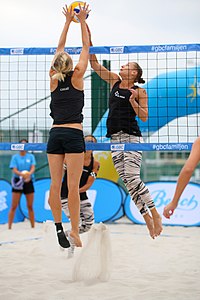
Photo from wikipedia
A next-generation sequencing (NGS) approach, in conjunction with culture-based methods, was used to examine fungal and prokaryotic communities for the presence of potential pathogens in beach sands throughout Portugal. Culture-based… Click to show full abstract
A next-generation sequencing (NGS) approach, in conjunction with culture-based methods, was used to examine fungal and prokaryotic communities for the presence of potential pathogens in beach sands throughout Portugal. Culture-based fungal enumeration revealed low and variable concentrations of the species targeted (yeasts and dermatophytes), which were underrepresented in the community characterized by NGS targeting the ITS1 region. Conversely, NGS indicated that the potentially pathogenic species Purpureocillium liliacinum comprised nearly the entire fungal community. Culturable fecal indicator bacterial concentrations were low throughout the study and unrelated to communities characterized by NGS. Notably, the prokaryotic communities characterized revealed a considerable abundance of archaea. Results highlight differences in communities between methods in beach sand monitoring but indicate the techniques offer complementary insights. Thus, there is a need to leverage culture-based methods with NGS methods, using a toolbox approach, to determine appropriate targets and metrics for beach sand monitoring to adequately protect public health.
Journal Title: Marine pollution bulletin
Year Published: 2017
Link to full text (if available)
Share on Social Media: Sign Up to like & get
recommendations!